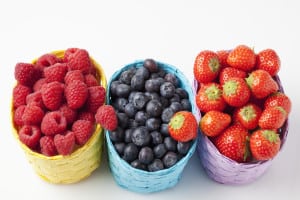
Fructose is a naturally occurring simple sugar found in fruit, vegetables and honey. Fructose is used to sweeten foods like jellies, soft drinks, gelatin, ice cream, candy, and certain diet foods.
When your body can’t absorb fructose appropriately, it can lead to digestive issues like gas, bloating, diarrhea and abdominal cramping and it is known as fructose intolerance. A fructose-free (low-sugar diet) is the best treatment for fructose intolerance.
Tips
- Avoid agave, fructose, high fructose corn syrup, and honey, molasses, sorghum, palm and coconut sugar.
- Limit drinks that contain high fructose corn syrup like pop, fruit juice and iced tea.
- Limit processed baked goods, canned fruit, jams, sauces, candy and other foods that contain high fructose corn syrup.
- Cooked vegetables and fresh or frozen fruit may be better tolerated.
- Be aware that every individual can have a lower or high tolerance of certain foods than others. This tolerance can depend on the amount consumed at one time.
| Food | Serving Size | Best | Limit | Avoid |
| Fruits | ½ cup of cut up fruit or 1 medium whole fruit (size of baseball) Limit 1 to 2 servings a day | Apricot, avocado, bananas, blackberries, cherries, lemons, limes, nectarine, oranges, peach, pineapple, raspberries, strawberries, rhubarb, plum, peach, papaya and passionfruit | Canned fruit in high fructose corn syrup, fruit juices, sugar-free jams and jellies | Apples, applesauce, dried fruit, grapes, kiwi, lychee, mango, pears, prunes and watermelon |
| Food | Serving Size | Best | Limit | Avoid |
| Vegetables | ½ cup of most vegetables or 1 cup of greens | Asparagus, celery, cucumber, lettuce, parsnips, pumpkin, radish, scallions, spinach, kale, zucchini, brussels sprouts, bamboo shoots, bok choy , chives and white potato | Broccoli, carrots, cauliflower, corn, eggplant, green beans, green peas, green peppers, sweet potato and tomatoes | Ketchup, pickles, sugar snap peas, sweet corn, tomato paste and tomato sauce |
| Food | Serving Size | Best | Limit | Avoid |
| Sweeteners | Tolerance can vary on the amount eaten in one sitting | Barley malt syrup, brown rice syrup, brown sugar, dextrose, glucose or glucose syrups, raw or turbinado sugar, Stevia | Aspartame (Equal or Nutrasweet), Sucralose (Splenda), real maple syrup (1 tbsp limit) andsugar alcohols such as mannitol, sorbitol and xylitol | Agave syrup, caramel, fructose, high fructose corn syrup, honey, invert sugar, licorice, molasses, pancake syrup, palm sugar and sorghum |
| Other Foods | Serving Size | Best | Limit | Avoid |
| Varies | All meat, all fats, all eggs, all dairy (plain, unsweetened and unflavored) | All beans (they are low in fructose but causes gas) Jams, jellies, baked beans, bbq sauces and other bottled dressings and sauces. | Desserts that contain fructose like cookies or ice cream, processed food with fructose on the label. |
References
Mayo Clinic. 2024. Fructose Intolerance: Which Foods to Avoid. https://www.mayoclinic.org/fructose-intolerance/expert-answers/faq-20058097
University of Virginia. 2023. Low Fructose Diet. https://med.virginia.edu/ginutrition/wp-content/uploads/sites/199/2023/12/Low-Fructose-2023.pdf


